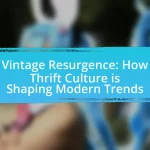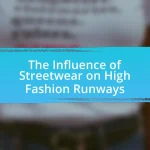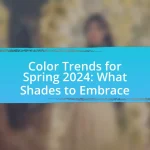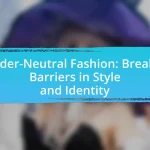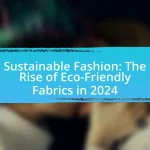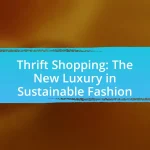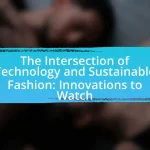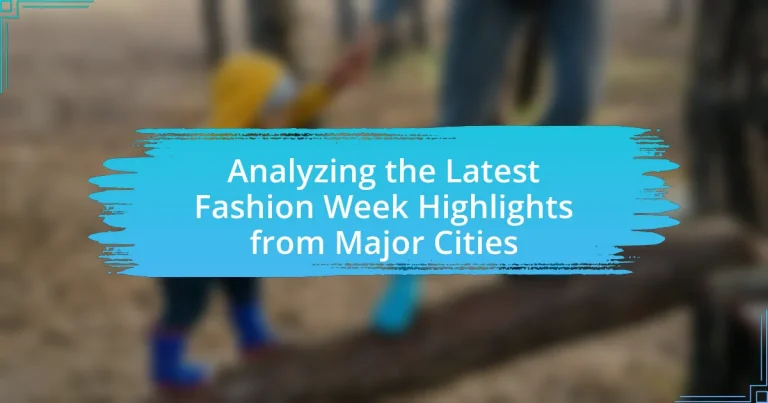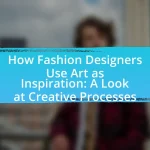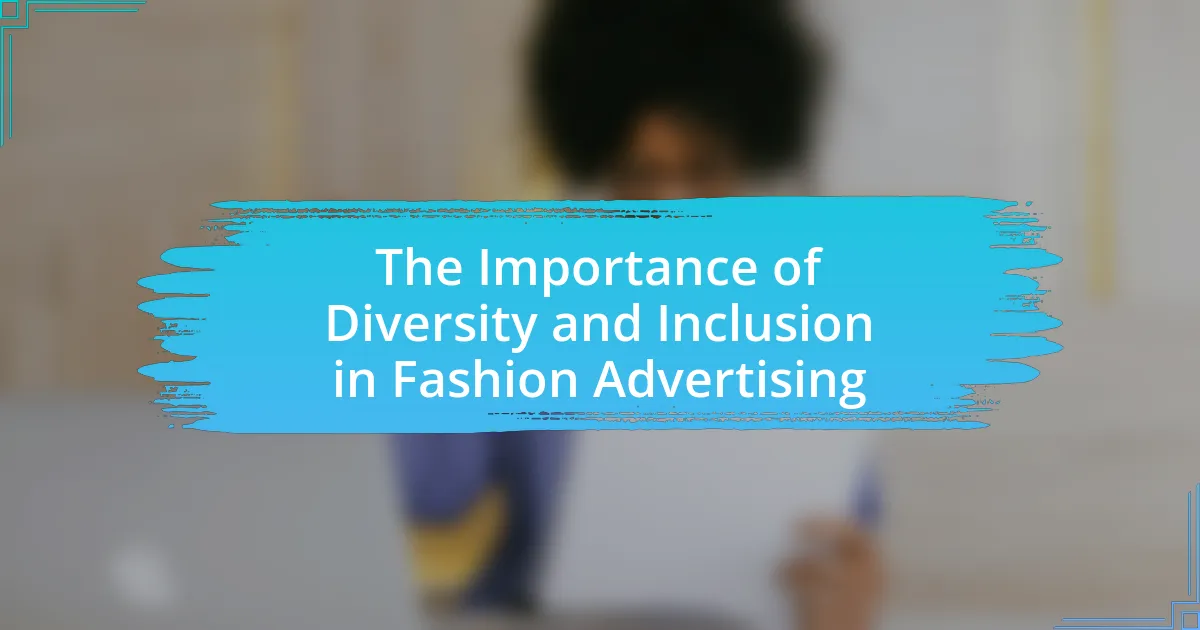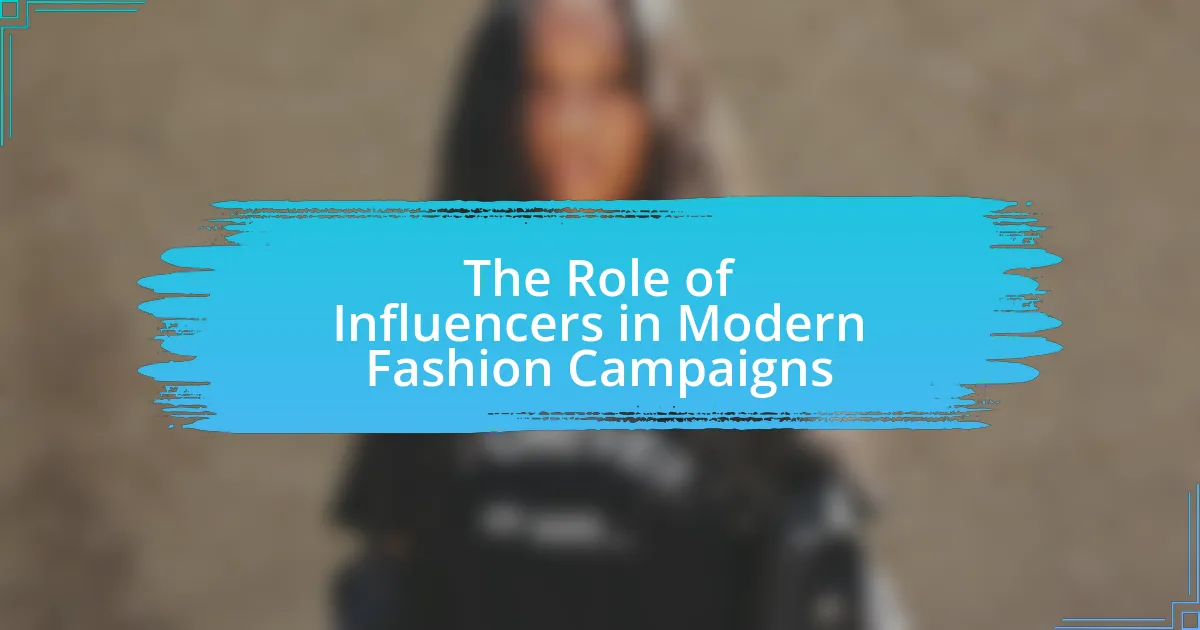The article analyzes the latest highlights from major Fashion Weeks in cities such as New York, Paris, Milan, and London, focusing on innovative designs, diverse models, and sustainability initiatives. Key trends include bold colors, oversized silhouettes, and a significant emphasis on eco-friendly materials. The article compares the distinct styles and cultural influences of each city’s Fashion Week, discusses the impact of technology and social media on presentations, and highlights collaborations between brands. Additionally, it offers practical insights for consumers and aspiring designers on incorporating runway trends into their wardrobes and understanding market demands.
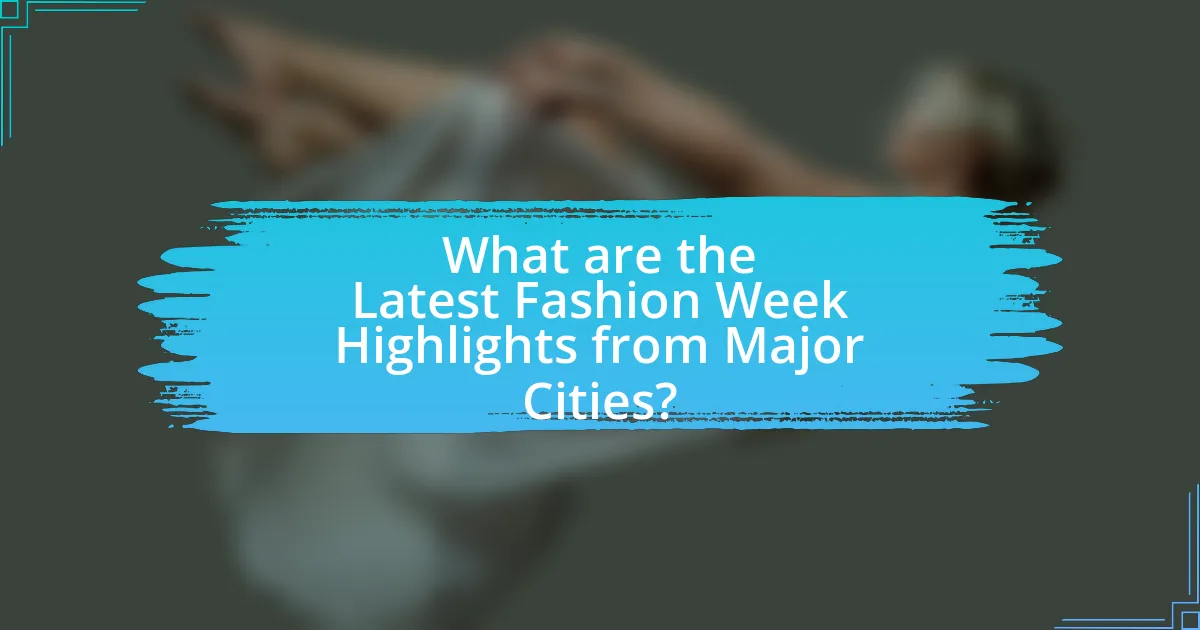
What are the Latest Fashion Week Highlights from Major Cities?
The latest Fashion Week highlights from major cities include innovative designs, diverse models, and sustainability initiatives. In New York, designers showcased bold colors and oversized silhouettes, while Paris emphasized craftsmanship and luxury fabrics. Milan featured a blend of streetwear and high fashion, with many brands focusing on eco-friendly materials. London highlighted inclusivity, with a significant number of plus-size and gender-neutral collections. These trends reflect the evolving landscape of fashion, where creativity meets social responsibility and representation.
How do Fashion Weeks in Different Cities Compare?
Fashion Weeks in different cities vary significantly in terms of style, cultural influence, and industry focus. For instance, New York Fashion Week is known for its commercial approach and emphasis on ready-to-wear collections, showcasing a blend of established and emerging designers. In contrast, Paris Fashion Week is often regarded as the pinnacle of haute couture, emphasizing luxury and artistry, with many of the world’s top fashion houses presenting their most innovative designs. London Fashion Week tends to highlight avant-garde and experimental styles, reflecting the city’s eclectic fashion scene, while Milan Fashion Week is synonymous with high-end craftsmanship and Italian luxury brands. Each city’s Fashion Week not only showcases unique aesthetics but also attracts different audiences and media attention, influencing global fashion trends.
What unique trends emerged from New York Fashion Week?
Unique trends that emerged from New York Fashion Week include bold color palettes, oversized silhouettes, and a resurgence of Y2K aesthetics. Designers showcased vibrant hues like electric blue and neon green, reflecting a shift towards optimism in fashion. Additionally, oversized garments, such as baggy trousers and voluminous coats, dominated the runway, emphasizing comfort and a relaxed fit. The Y2K revival was evident through the incorporation of low-rise jeans, crop tops, and playful accessories, signaling a nostalgic return to early 2000s styles. These trends highlight a blend of comfort, nostalgia, and vibrant expression in contemporary fashion.
How did Paris Fashion Week set the tone for global fashion?
Paris Fashion Week set the tone for global fashion by showcasing innovative designs and trends that influence the industry worldwide. The event featured prominent designers like Chanel and Dior, who presented collections that emphasized sustainability and inclusivity, reflecting a shift in consumer values. Additionally, the presence of high-profile celebrities and influencers at the shows amplified the visibility of these trends, leading to widespread adoption across various markets. The impact of Paris Fashion Week is evident in the subsequent collections from other fashion capitals, which often draw inspiration from the themes and styles introduced during this pivotal event.
What innovations were showcased at Milan Fashion Week?
Milan Fashion Week showcased several innovations, including the integration of sustainable materials and digital technology in fashion design. Notably, brands like Gucci and Prada highlighted eco-friendly fabrics, while designers utilized augmented reality to enhance the runway experience. This emphasis on sustainability aligns with the growing industry trend towards environmentally conscious fashion, as evidenced by a 2022 McKinsey report indicating that 67% of consumers consider sustainability when making fashion purchases.
What cultural influences were evident in London Fashion Week?
Cultural influences evident in London Fashion Week included a strong representation of British heritage, global multiculturalism, and sustainability. Designers showcased traditional British tailoring alongside contemporary streetwear, reflecting the nation’s rich fashion history while embracing diverse cultural elements from around the world. For instance, collections featured patterns and textiles inspired by African and Asian cultures, highlighting London’s status as a melting pot of global influences. Additionally, many designers emphasized eco-friendly practices, aligning with the growing cultural movement towards sustainability in fashion, as seen in the use of recycled materials and ethical production methods.
Why are Fashion Week Highlights Important for the Industry?
Fashion Week highlights are crucial for the industry as they showcase emerging trends, set the tone for upcoming seasons, and influence consumer behavior. These events provide a platform for designers to present their collections, allowing industry professionals, buyers, and media to identify key styles and innovations. For instance, the Spring/Summer 2023 Fashion Week in New York revealed a significant shift towards sustainable fashion, with 40% of designers incorporating eco-friendly materials, reflecting a growing consumer demand for sustainability. This data underscores the importance of Fashion Week highlights in shaping industry standards and guiding future design directions.
How do these highlights influence consumer trends?
The highlights from major Fashion Weeks significantly influence consumer trends by setting the tone for upcoming styles and preferences. Designers showcase innovative designs, colors, and materials that often dictate what consumers will seek in retail. For instance, the prominence of sustainable fashion at recent Fashion Weeks has led to a marked increase in consumer demand for eco-friendly products, with a report from McKinsey indicating that 67% of consumers consider sustainability when making a purchase. This shift in focus not only reflects changing consumer values but also drives brands to adapt their offerings to align with these emerging trends.
What role do designers play in shaping these highlights?
Designers play a crucial role in shaping the highlights of Fashion Week by creating innovative collections that set trends and influence the industry. Their designs reflect cultural, social, and artistic movements, often showcasing unique aesthetics that resonate with audiences. For instance, during the 2023 New York Fashion Week, designers like Marc Jacobs and Prabal Gurung introduced bold colors and sustainable materials, which not only captured attention but also sparked discussions about environmental responsibility in fashion. This demonstrates how designers not only present their vision but also drive conversations that shape the future of fashion.
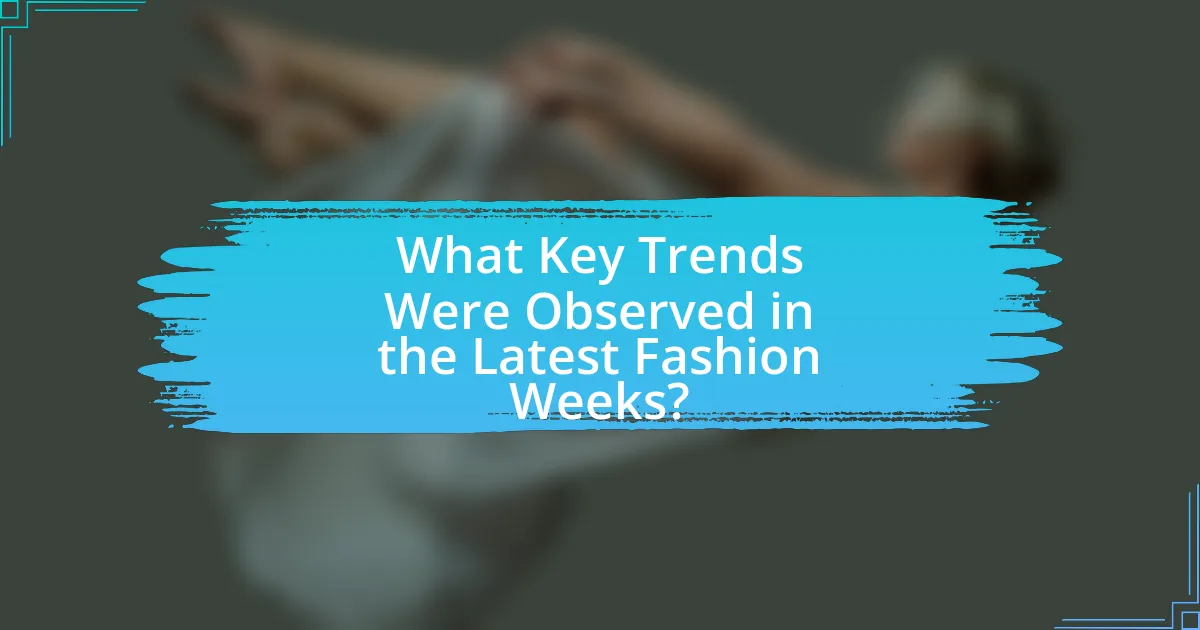
What Key Trends Were Observed in the Latest Fashion Weeks?
Key trends observed in the latest fashion weeks include a resurgence of bold colors, oversized silhouettes, and a focus on sustainability. Designers showcased vibrant hues such as electric blue and neon green, reflecting a shift towards more expressive fashion choices. Oversized garments, including baggy trousers and voluminous coats, dominated the runways, emphasizing comfort and a relaxed aesthetic. Additionally, many brands highlighted eco-friendly materials and ethical production practices, aligning with the growing consumer demand for sustainable fashion. This trend is supported by data indicating that 67% of consumers consider sustainability when making fashion purchases, showcasing the industry’s response to environmental concerns.
Which styles dominated the runway this season?
This season, oversized silhouettes and bold colors dominated the runway. Designers showcased voluminous garments, such as oversized coats and wide-leg trousers, emphasizing comfort and statement-making aesthetics. Additionally, vibrant hues like electric blue, fiery red, and neon green were prevalent, reflecting a shift towards more expressive and eye-catching fashion choices. This trend aligns with the growing consumer demand for individuality and self-expression in clothing, as noted in recent fashion industry reports.
What colors were most prevalent in the collections?
The most prevalent colors in the collections from the latest Fashion Week highlights were shades of blue, earthy tones, and vibrant reds. Blue dominated many collections, reflecting a trend towards calm and serene aesthetics, while earthy tones such as browns and greens emphasized a connection to nature. Vibrant reds were also prominent, symbolizing energy and boldness in various designs. These color trends align with the overarching themes of sustainability and emotional expression observed in the fashion industry during this period.
How did sustainability influence design choices?
Sustainability significantly influenced design choices by prioritizing eco-friendly materials and ethical production practices. Designers increasingly opted for organic fabrics, recycled materials, and low-impact dyes to reduce environmental harm. For instance, during the latest Fashion Week, brands like Stella McCartney showcased collections made from sustainable textiles, reflecting a commitment to reducing waste and carbon footprints. This shift aligns with consumer demand for transparency and responsibility in fashion, as evidenced by a 2022 survey indicating that 66% of consumers consider sustainability when making purchasing decisions.
What Accessories and Footwear Trends Were Notable?
Notable accessories and footwear trends from recent fashion weeks include oversized bags, chunky sneakers, and statement belts. Oversized bags have gained popularity for their practicality and bold aesthetic, often seen in collections from major designers like Balenciaga and Gucci. Chunky sneakers continue to dominate, reflecting a shift towards comfort and streetwear influences, with brands like Balenciaga and Nike leading the charge. Additionally, statement belts have emerged as key accessories, often used to cinch oversized silhouettes, enhancing outfits with a touch of sophistication, as showcased in collections by designers such as Versace and Prada. These trends highlight a blend of functionality and style that resonates with contemporary fashion sensibilities.
Which accessories stood out during the shows?
The accessories that stood out during the shows included oversized sunglasses, statement belts, and bold jewelry pieces. Oversized sunglasses were prominently featured across various collections, enhancing the dramatic flair of outfits. Statement belts, often adorned with unique buckles, were used to cinch waists and add structure to flowing garments. Bold jewelry pieces, such as chunky necklaces and oversized earrings, served as focal points, drawing attention and elevating the overall aesthetic of the ensembles. These trends reflect a shift towards more expressive and eye-catching accessory choices in contemporary fashion.
How did footwear trends evolve this season?
Footwear trends evolved this season towards a blend of comfort and bold aesthetics, prominently featuring chunky sneakers, platform boots, and vibrant colors. Major fashion weeks showcased these styles, reflecting a shift in consumer preference for both practicality and statement pieces. For instance, during New York Fashion Week, designers like Balenciaga and Prada highlighted oversized silhouettes and eye-catching designs, indicating a clear trend towards footwear that combines functionality with high fashion.

How Did Designers and Brands Showcase Their Collections?
Designers and brands showcased their collections through a combination of traditional runway shows, digital presentations, and immersive experiences. Major fashion weeks, such as those in New York, Paris, and Milan, featured live runway events where models displayed the latest designs in front of industry professionals and media. Additionally, many brands adopted digital formats, including livestreams and virtual reality experiences, to reach a broader audience, especially during the pandemic. For instance, the Spring/Summer 2022 collections saw brands like Balenciaga and Gucci utilizing innovative digital platforms to enhance viewer engagement and accessibility. This shift reflects the industry’s adaptation to changing consumer behaviors and technological advancements.
What innovative presentation formats were used?
Innovative presentation formats used during the latest Fashion Week highlights included virtual reality experiences, live-streamed runway shows, and interactive digital lookbooks. These formats allowed designers to reach a broader audience and engage viewers in immersive ways. For instance, virtual reality experiences enabled attendees to experience shows from different perspectives, while live-streamed events attracted global viewers, significantly increasing audience engagement compared to traditional in-person shows. Interactive digital lookbooks provided a dynamic way for consumers to explore collections, enhancing the overall presentation and accessibility of fashion.
How did technology enhance the viewing experience?
Technology enhanced the viewing experience by providing high-definition streaming, augmented reality features, and interactive platforms. High-definition streaming allows viewers to see intricate details of fashion designs, improving visual clarity and engagement. Augmented reality features enable users to visualize clothing items in their own environment, enhancing personal connection to the fashion showcased. Interactive platforms, such as social media and live chats, facilitate real-time audience participation and feedback, creating a more immersive experience. These technological advancements have transformed how audiences engage with fashion events, making them more accessible and engaging.
What role did social media play in the showcases?
Social media played a crucial role in the showcases by amplifying visibility and engagement for designers and brands. Platforms like Instagram and TikTok allowed real-time sharing of runway moments, enabling a global audience to experience the events as they unfolded. For instance, during New York Fashion Week 2023, over 1.5 million posts were tagged with relevant hashtags, demonstrating the extensive reach and influence of social media in shaping public perception and trends in the fashion industry.
What Collaborations and Partnerships Were Highlighted?
The highlighted collaborations and partnerships during the latest Fashion Week included notable alliances between established fashion houses and emerging designers, as well as partnerships with technology companies to enhance digital experiences. For instance, a prominent collaboration featured a luxury brand teaming up with a tech firm to create augmented reality experiences for runway shows, showcasing innovative ways to engage audiences. Additionally, several brands partnered with sustainable fashion initiatives, emphasizing eco-friendly practices and materials, which reflects a growing trend in the industry towards sustainability. These collaborations not only enhance brand visibility but also align with current consumer values, making them significant in the context of the fashion industry’s evolution.
Which brands partnered for exclusive collections?
Brands that partnered for exclusive collections include Gucci and The North Face, which collaborated to create a unique outdoor apparel line. This partnership was highlighted during the 2021 Milan Fashion Week, showcasing a blend of luxury and functionality. Additionally, Balenciaga and Adidas teamed up for a collection that merges high fashion with sportswear, further emphasizing the trend of cross-industry collaborations in the fashion sector.
How did collaborations impact the overall fashion narrative?
Collaborations significantly transformed the overall fashion narrative by merging diverse creative visions and expanding market reach. Notable partnerships, such as those between high-end designers and streetwear brands, have blurred traditional boundaries, leading to innovative designs that resonate with broader audiences. For instance, the collaboration between Louis Vuitton and Supreme in 2017 generated over $1 billion in sales, illustrating how such alliances can redefine brand identity and consumer engagement. These collaborations not only enhance visibility but also foster inclusivity, allowing various cultural influences to shape contemporary fashion trends.
What Practical Tips Can Be Learned from the Latest Fashion Weeks?
Practical tips learned from the latest Fashion Weeks include embracing bold colors, layering techniques, and sustainable fashion choices. Designers showcased vibrant hues and unexpected color combinations, encouraging individuals to experiment with their wardrobe. Layering was prominently featured, demonstrating how to combine different textures and lengths for a stylish look. Additionally, the emphasis on sustainability highlighted the importance of investing in quality pieces and supporting eco-friendly brands, reflecting a growing consumer demand for responsible fashion. These insights are derived from the trends observed in major cities like New York, Paris, and Milan, where designers set the tone for upcoming seasons.
How can consumers incorporate runway trends into their wardrobes?
Consumers can incorporate runway trends into their wardrobes by selecting key pieces that reflect the latest styles showcased during fashion weeks. For instance, if oversized blazers are trending, consumers can invest in a tailored oversized blazer to modernize their outfits. Additionally, they can mix high-fashion items with their existing wardrobe staples, such as pairing a trendy statement top with classic jeans. This approach allows consumers to stay fashionable without overhauling their entire wardrobe. Fashion experts often recommend focusing on a few standout trends each season, which can be easily integrated into everyday wear, ensuring that consumers remain stylish while maintaining their personal style.
What should aspiring designers take away from these events?
Aspiring designers should take away the importance of current trends and innovative techniques showcased at major fashion events. These events serve as a platform for industry leaders to present cutting-edge designs, allowing emerging designers to understand market demands and consumer preferences. For instance, the Spring/Summer 2023 Fashion Week highlighted sustainable practices and inclusivity, which are increasingly vital in the fashion industry. By observing these trends, aspiring designers can align their work with contemporary values and enhance their marketability.
